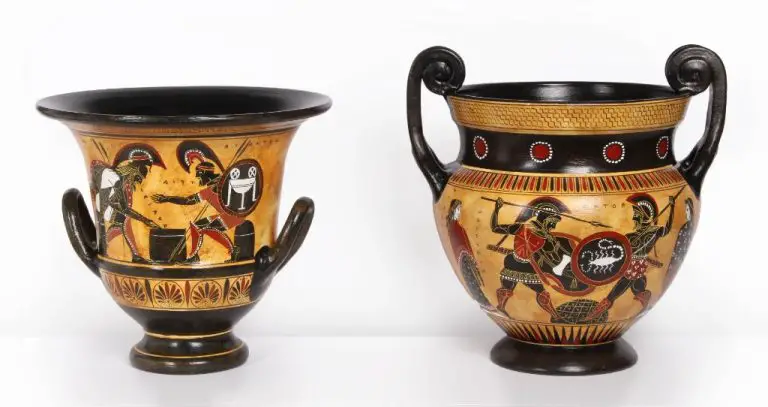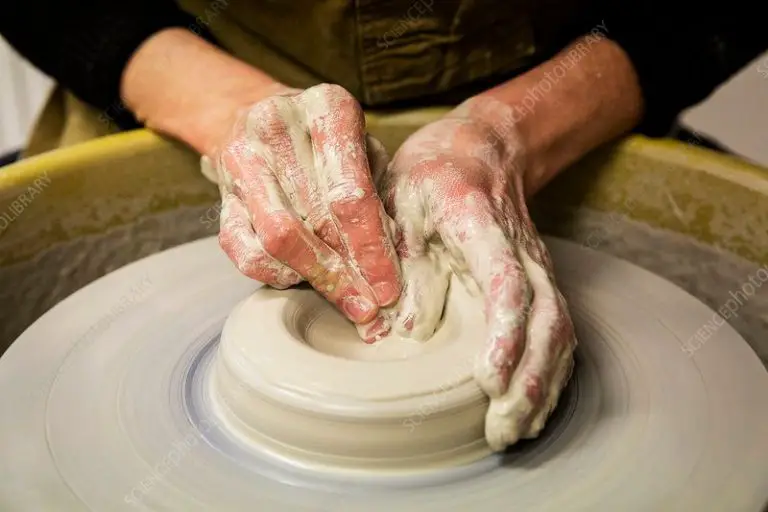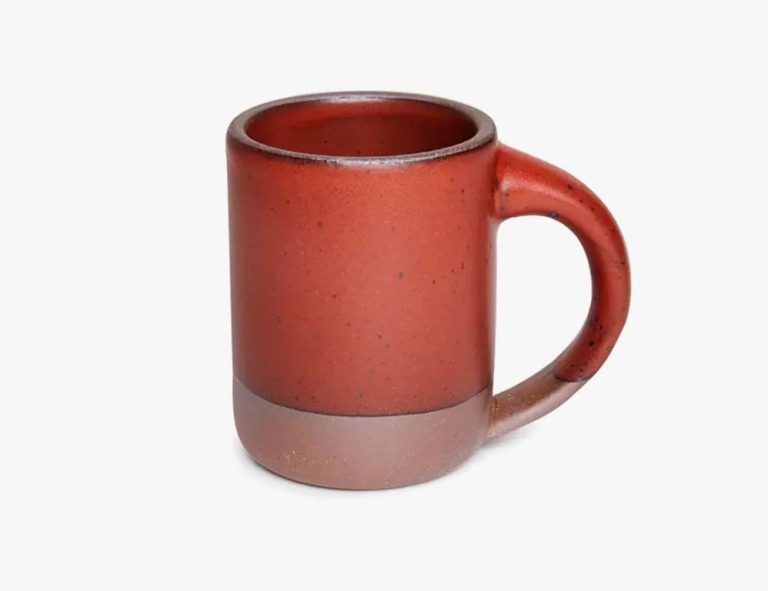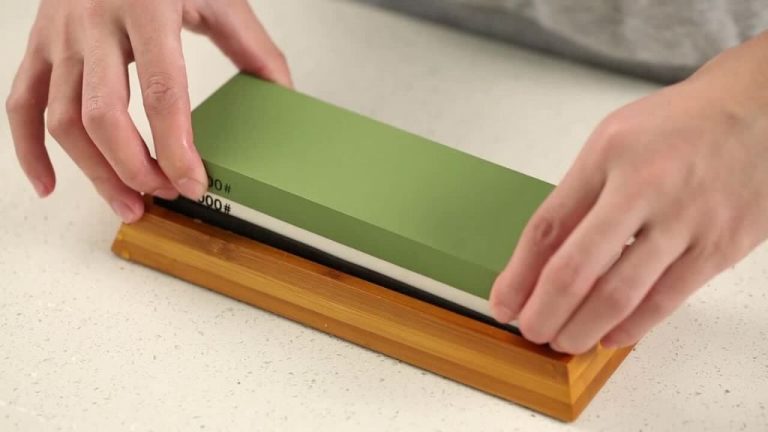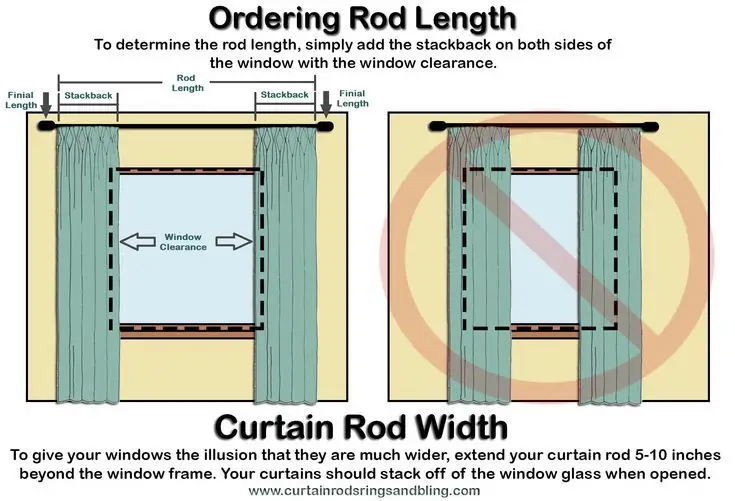How Do You Use Cobalt Carbonate In Pottery?
Cobalt carbonate is a chemical compound with the formula CoCO3. It is composed of the metal cobalt and carbonate ions. Cobalt carbonate appears as a rose-red or pink powder.
Cobalt carbonate has been used to color glass and ceramics for thousands of years. The ancient Egyptians and Chinese used cobalt compounds to create blue colored pottery and tiles. It was not until the 19th century that cobalt’s use became widespread with the development of cobalt blue dyes and pigments. Today, cobalt carbonate remains a popular material for coloring and glazing pottery.
Cobalt carbonate is appreciated for its intense blue color in pottery glazes and can be used to achieve a wide range of hues from light sky blue to dark navy when fired in oxidation. According to Jill Rutter of jillrutter.com, cobalt carbonate is “widely used in ceramics, usually as cobalt oxide or cobalt carbonate powder, two among a range of chemical compounds that are generically referred to as cobalt blue”. Its vibrancy makes it a prized material for potters seeking to add striking blues to their work.
Chemical Properties of Cobalt Carbonate
Cobalt carbonate has the chemical formula CoCO3. Its IUPAC name is cobalt(II) carbonate or cobaltous carbonate. It has a reddish or pink color and forms rhombohedral crystals (PubChem).
Cobalt carbonate is insoluble in water, as well as alcohol and ammonia solutions. It has low solubility in mineral acids like hydrochloric acid and nitric acid (Wikipedia).
Cobalt carbonate is considered toxic if inhaled or ingested. It can cause irritation to the eyes, skin, respiratory tract and gastrointestinal tract. Precautions should be taken when handling it, including using protective equipment and avoiding inhalation of dust (PubChem).
Why Cobalt Carbonate is Used in Pottery Glazes
Cobalt carbonate is primarily used in pottery glazes because it provides a distinctive blue color. When added to glazes and fired in a kiln, cobalt carbonate produces a brilliant blue hue that has been prized by potters and ceramic artists for centuries.
In addition to its vibrant blue color, cobalt carbonate is also favored for glazes because of its stability at high temperatures. Glazes must withstand extremely high heat during the firing process, often over 2,000°F. Many compounds that produce color either burn off or decompose when fired at these temperatures. However, cobalt carbonate is able to endure these high heat levels without burning away or losing its coloring properties.
The high temperature stability of cobalt carbonate makes it an ideal choice for coloring glazes across different types of pottery and ceramic ware. From porous earthenware fired at lower temperatures, to smooth stoneware and porcelain fired at over 2,300°F, cobalt carbonate can provide its signature blue hues. This versatility and reliability under high heat makes cobalt carbonate a staple ingredient for potters wanting to add blue color in their glazes.
Using Cobalt Carbonate in Pottery Glazes
Cobalt carbonate is commonly used at 0.5-3% in glazes to produce blue colors. It can be added to any base glaze recipe, but lower percentages around 0.5-1% tend to work best for achieving vibrant blues without oversaturation. Cobalt carbonate should be weighed out carefully on a scale and added slowly to the glaze slurry while mixing well to incorporate evenly. Care should be taken not to inhale the fine cobalt powder when mixing. If adding to a premade commercial glaze, estimate the equivalent dry weight and add conservatively in small increments until desired color is reached.
For firing, stoneware glazes with cobalt carbonate should be fired between cone 6 and 10 (2232°F-2345°F) for the full development of the blue color. Firing too low will result in lighter purple-greys, while too high can burn out the blue to pale green. Fast firing is preferred to prevent excessive burnout. Consider applying a reducer at peak temperature for 5-15 minutes to enhance and stabilize the blue color. Test tiles should be fired at a range of cones to determine the optimal temperature for the specific glaze recipe used.
Source: https://digitalfire.com/material/cobalt+carbonate
Achieving Different Colors with Cobalt
Cobalt carbonate can produce a wide range of blue and purple hues in pottery glazes. The specific color that results depends on several factors:
Glaze chemistry – Adding cobalt carbonate to a glaze with high alkaline content will yield purple tones, while more neutral glazes will be blue. Alkaline glazes contain materials like wood ash, dolomite, or whiting.
Firing temperature – Cobalt shifts toward purple and darker blue hues at higher kiln temperatures above cone 6. At lower temperatures in the cone 04-6 range, brighter blues are achieved.
Percentage of cobalt – Using 1-3% cobalt carbonate typically produces light to medium blue. Higher amounts of 4-6% yield dark midnight blues trending toward black.
Other glaze materials like copper, iron, and titanium interact with the cobalt during firing to modify the blues. Combining cobalt and iron can create deeper navy hues.
The cobalt blue color can range from pale sky blue to dark midnight shades of purple-blue. Factors like glaze chemistry, kiln temperature, and amount of cobalt carbonate determine the final results.
For more details on how firing temperature affects cobalt colors, see this reference: https://digitalfire.com/material/cobalt+carbonate
Complementary Glaze Colors with Cobalt
Cobalt blue glazes pair beautifully with creamy white or ivory glazes. The contrast between the crisp blue and soft white creates an eye-catching effect. Some popular white glaze options to complement cobalt blue include:
Cone 6 Porcelain Matte Glaze – This smooth, semi-matte glaze has a creamy white color that allows the cobalt blue to really pop. It can be found at many ceramic supply stores and online at sites like https://www.clay-planet.com/porcelain-matte-glaze-c6.html
Crystalline Glaze – Crystalline glazes develop shiny crystalline formations when fired, giving a unique contrast against the solid cobalt blue. Recipes can be found in resources like Mastering Crystalline Glazes by Diane Creber.
Simple Satin White – A basic cone 6 recipe with tin and zirconium that creates a bright white satin glaze. The finish nicely highlights cobalt’s intensity. Find recipes at https://ceramicartsnetwork.org.
Light ivory glazes also pair beautifully with cobalt blue. Their subtle warmth creates a pleasant contrast against the cooler blue tone. Some ivory glaze options include Mayco’s “Buttercup” glaze and Amaco’s “Ivory” glaze.
Cobalt Carbonate Glaze Recipes
Cobalt carbonate is commonly used to produce beautiful blue glazes in pottery. Here are some example recipes for cobalt blue glazes:
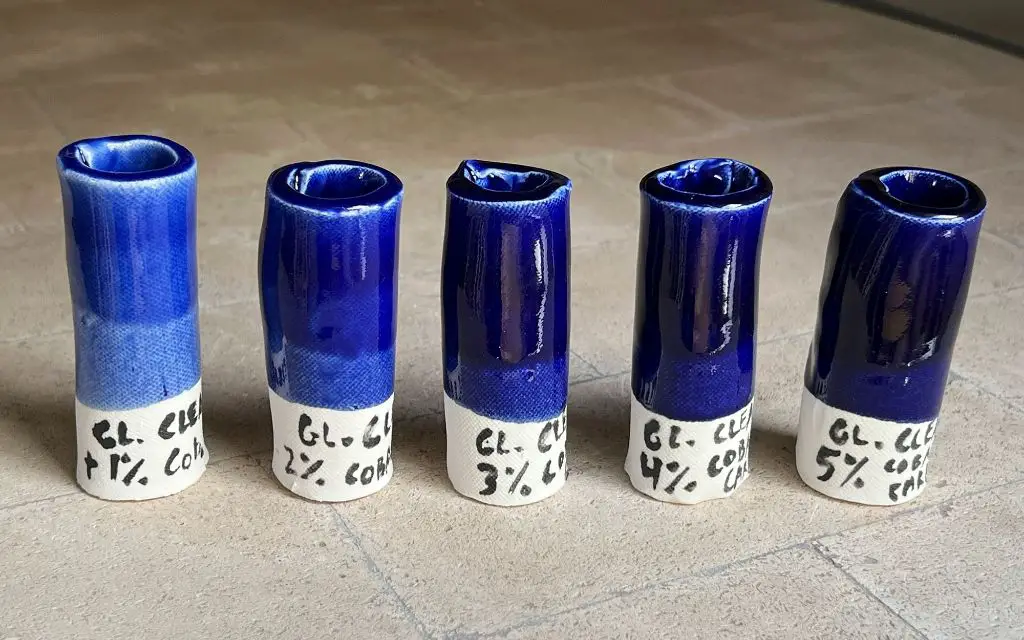
This is a simple cobalt blue glaze recipe from Ceramic Arts Network:
- 25% Gerstley Borate
- 25% Kaolin
- 25% Silica
- 25% Nepheline Syenite
- 6-10% Cobalt Carbonate
The percentage of cobalt carbonate used will determine the depth of blue. Start with 6% and test adding more if a deeper blue is desired.
Here is another popular cobalt blue recipe from Glazy.org:
- 13.3% Whiting
- 26.6% Dolomite
- 20% Frit 3134
- 20% Kaolin
- 20% Silica
- 3-5% Cobalt Carbonate
This glossy cobalt blue glaze works well on stoneware and porcelain. Adjust the percentage of cobalt carbonate to control the color saturation.
For an earthy matte cobalt blue, Digital Fire recommends:
- 29.4% Ferro Frit 3195
- 21.1% Kaolin
- 29.4% Silica
- 14.7 EPK Kaolin
- 5.3% Cobalt Carbonate
Test small batches first, as the cobalt percentage required can vary by brand. Too much cobalt carbonate can cause glaze defects.
Tips for Using Cobalt Carbonate
When working with cobalt carbonate in pottery glazes, there are some important safety precautions and best practices to follow:
Precautions for toxicity:
- Cobalt compounds are toxic and should be handled carefully. Wear a dust mask when mixing dry cobalt carbonate powder.
- Work in a well-ventilated area and avoid breathing in cobalt dust.
- Wash your hands thoroughly after handling cobalt carbonate.
- Be mindful that cobalt leaching into food can be hazardous, so test any functional ware thoroughly.
Mixing instructions:
- Start by mixing a cobalt carbonate slurry of equal parts cobalt carbonate powder and water. Add water gradually until you reach the desired consistency.
- Mix the cobalt carbonate slurry into your glaze recipe starting with small amounts like 1-3% of the dry glaze weight. Test increasing increments.
- Stir the glaze mixture thoroughly to fully incorporate the cobalt carbonate.
Test tiles:
- Always test a range of cobalt carbonate percentages on test tiles before applying to finished pieces.
- Testing will show the effects of different percentages on the final color and allow you to find the ideal amount of cobalt carbonate for your desired glaze color and effect.
- Apply the test glazes to test tiles under the same firing conditions you will use on finished ware.
Following proper safety precautions when mixing and testing cobalt carbonate in glazes will lead to beautiful results.
Notable Cobalt Glazed Pottery
Cobalt blue glazes have been used for centuries to create some of the most iconic pottery pieces throughout history. Some of the most famous examples include:
Ming Dynasty Porcelain – Cobalt blue and white porcelain reached extraordinary levels of perfection during the Ming Dynasty in China between the 14th-17th centuries. Famed examples include the blue and white porcelain from Jingdezhen, which became highly prized by nobility and royalty across Europe, the Middle East, and Asia.
Delftware – This tin-glazed pottery made in the Netherlands was originally inspired by Chinese porcelain. Delft potters began using cobalt blue decorations in the mid-17th century to imitate the sought after Chinese porcelains. Delftware remains popular today for its classic blue and white floral patterns.
Josiah Wedgwood’s Blue Jasperware – The iconic light blue matte finish and white relief decorations of Wedgwood Jasperware was achieved using cobalt in the 18th century. It remains one of the most recognizable ceramic styles today.
In modern pottery, cobalt blue glazes remain popular for creating vibrant pops of color. Contemporary examples include the works of renowned potters like Warren MacKenzie, who is known for his expressive brushwork and expert use of cobalt blue glazes. Other potters like Simon Levin combine cobalt blues with copper reds to create dramatic painterly effects. Cobalt continues to be a staple in many potters’ studios for its timeless yet versatile appeal.
Conclusion
Cobalt carbonate is an important material for creating beautiful colored glazes on pottery. When added to pottery glazes, cobalt carbonate produces rich blues and violets by interacting with the silica and alumina during firing. It also combines with other metal oxides to produce an array of colors. Key points covered in this article include:
- Cobalt carbonate is a inorganic salt that dissociates into cobalt and carbonate ions during firing, allowing it to melt into the glaze.
- Small amounts of cobalt carbonate produce deep blues, while larger amounts create lighter pastel blues and violets.
- Cobalt blends well with iron, copper, manganese and other oxides to produce more colors like greens, browns and grays.
- Cobalt carbonate should be added at 0.5-3% of the glaze recipe for best effects.
- Specific glaze recipes were provided using cobalt carbonate for blue and purple colors.
By understanding the chemical properties of cobalt carbonate and how to properly incorporate it into glaze recipes, potters can consistently produce beautiful ceramic pieces with cobalt colored glazes. The striking blues and violets achieved make the extra effort worthwhile.

